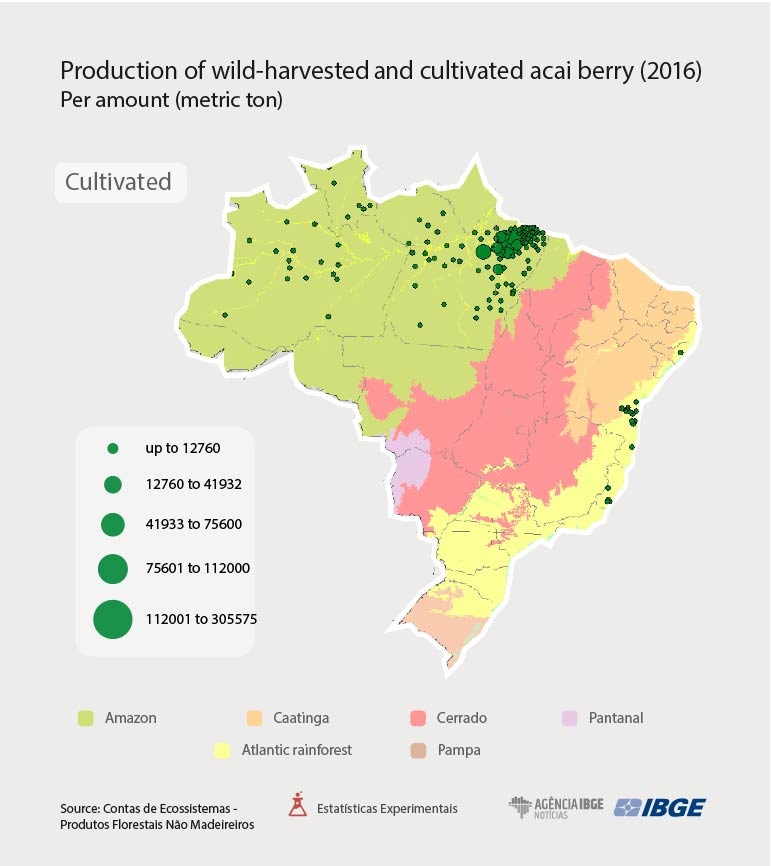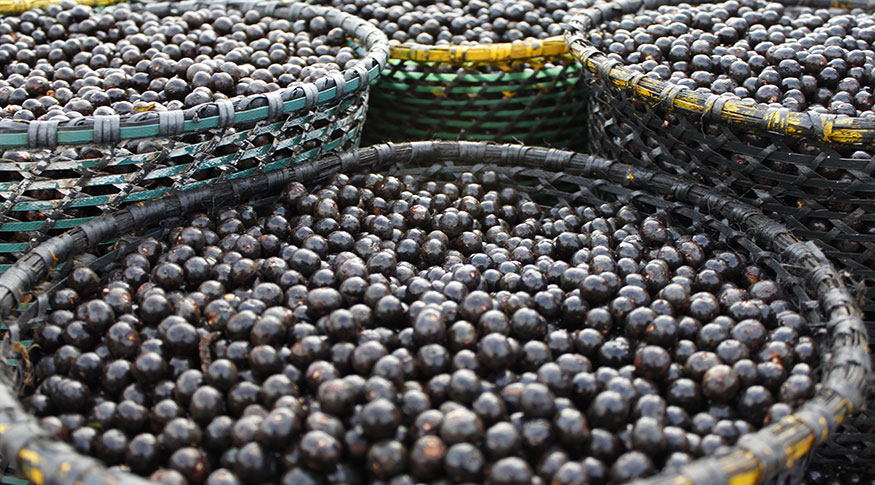Ecosystem Accounting
Experimental study analyzes amount and value of non-wood forest products per biome
April 15, 2021 10h00 AM | Last Updated: April 21, 2021 01h58 AM
Highlights
- The study shows physical and monetary evolution of 10 wild-harvested and cultivated products, between 2006 and 2016, still on an experimental basis: acai berry (wild-harvested and cultivated), coagulated latex (wild-harvested and cultivated), yerba mate (wild-harvested and cultivated), heart of palm (wild-harvested and cultivated), Brazil nut, pequi (fruit and nut), babassu, carnauba (wax and powder) jaborandi and piassava.
- This work aims at assessing the extension of environmental contribution to economic activity and the impact the use of these resources has on nature. Data is part of the IBGE’s System of Economic Accounts, in accordance with recommendations form the United Nations Organization (UN).
- The Amazon and the Cerrado are the biomes with the biggest variety of non-wood forest products analyzed.
- Pequi nut (-73%) and extracted coagulated latex (-70%) recorded the biggest decreases in production. Main increases in output were recorded by wild-harvested acai (113%), cultivated yerba mate (45%) and wild-harvested yerba mate (51%) and cultivated heart of palm (60%).
- In the Atlantic rainforest biome, a highlight is the production of 347 thousand metric tons of wild-harvested yerba mate and, in the Amazon, wild harvesting of acai berry (215 thousand metric tons).
- With significant appreciation in the national and international market, acai had an increase of 113% in the wild-harvested amount, with a change from 101.3 thousand metric tons in 2006 to 215.4 thousand metric tons in 2016.
- In 2016, the value of provisioning services for wild-harvested acai was estimated at R$ 703.1 million. For cultivated acai, the figure was R$ 2 billion.
The IBGE has released today (15) the Ecosystem Accounts: Non-Wood Forest Products, experimental statistics with studies on physical and monetary evolution of production in each biome of Brazil, between 2006 and 2016. The publication has two sections with independent methodologies: one that analyzes non-wood forest production per biome and another one that presents an estimate of the value of provision for those products.
These statistics form the System of Environmental Economic Accounting, which follows recommendations from the United Nations (UN), by promoting integration of information between the economy and the environment. The study and its results are experimental classes since they are still in the testing and evaluation phase. The publication intends to include society in the process of development of those indicators, from the initial stages.
The survey presents a catalogue of physical and monetary provision for the most economically significant wild-harvested and cultivated products, per biome, from 2006 and 2016: acai berry (wild-harvested and cultivated), coagulated latex (wild-harvested and cultivated), yerba mate (wild-harvested and cultivated), heart of palm (wild-harvested and cultivated), Brazil nut, pequi (fruit and nut), babassu, carnauba (wax and powder) jaborandi an piassava.
From 2006 to 2016, the Quantity Index (QI) shows decrease in production of wild-harvested heart of palm (-34%), babassu (-47%), piassava (-44%), carnauba wax (-45%) and carnauba powder (-51%). The most significant decrease was that of pequi nut (-73%), followed by wild-harvested coagulated latex (-70%).
On the other hand, there was increase of production of wild-harvested acai berry (113%), biggest in the survey (8%), besides coagulated latex (8%), cultivated yerba mate (45%) and wild-harvestedyerba mate (51%), cultivated heart of palm (60%), Brazil nut (21%) and jaborandi (2%).

Replacement of wild-harvested products for cultivated ones is clear. Highlights are coagulated latex (with a 70% decrease of the wild-harvestedproduced and an 80% increase of the cultivated version) and heart of palm (a 34% decrease versus a 60% increase).
Considering value of production at current prices, from the price Index analysis (IP), there was widespread rise of average prices, except of cacai berry (-55%). Carnauba wax and powder (237% and 244%, respectively), followed by wild-harvested yerba mate (207%) e pequi nut (202%).
“ The construction of Quantity and Price Indexes considered 2006 as base year, with statistics from the surveys on Municipal Agricultural Production (PAM) and on Forestry Activities (PEVS), thus enabling the identification of physical and monetary benefits generated by the collection of those products,” says Ivone Lopes Batista, technician in charge of the survey.
The Amazon is a highlight with the greatest variety of products
Among the biomes, a highlight in the Atlantic rainforest was wild-harvested yerba mate (347 thousand metric tons) and, in the Amazon, wild-crop harvesting of acai berry (215 thousand metric tons), Brazil nut (34 thousand metric ton) and babassu nut (16 thousand metric tons).
Among products cultivated in the Atlantic rainforest, also stand out: yerba mate (567 thousand metric tons) and coagulated latex (250 thousand metric tons). In the Cerrado, highlights are: cultivated coagulated latex (47 thousand metric ton) and heart of palm (16 thousand metric tons)./p>
It is worth pointing out the increase in volume of products cultivated as permanent crops, such as yerba mate (56%) and heart of palm (114%), both in the Atlantic rainforest and also of rubber, found in the Atlantic rainforest (84%), Pantanal (447%) and Cerrado (79%).

Value of production of acai berry increases by 398% in 10 years
Acai berry is one of the most desired species from forests, highly appreciated in the national and in the foreign market due to its nutritional characteristics. From 2006 to 2016, the wild-harvested amount of acai recorded a 113% increase, from 101.3 to 215.4 thousand metric tons.
Value of production (VOP) of wild-harvested acai berry, which was of R$ 103.2 million in 2006, went to R$ 514.2 million in 2016, and accounted, respectively, for 22.3% and 39.7% of the total VOP of wild-harvested non-wood forest products. That 398% increase resulted from the rise of the average price and the reduced amount of acai produced in the period.
Study indicates Experimental Valuation of Provisioning Services
The second section of the survey presents a study about the Experimental Valuation of Provisioning Services. “The calculation of Valuation of Provisioning Services uses data from the 2006 Census of Agriculture, besides the Municipal Agricultural Production (PAM), Forestry Activities (PEVS) and variables from the System of National Accounts,” says Michel Lapip, manager of the study. “Provisioning is the category of ecosystem-related services that encompasses products obtained directly from the ecosystem, such as food, natural fiber, wood for fuel, water, etc.”
In 2016, Value of Provisioning Services of wild-harvested products was estimated at R$ 703.1 million for acai berry, R$ 65.1 million for babassu nut, R$ 55 million for Brazil nut, R$ 47.2 million for heart of palm, R$ 34.8 million for carnauba powder, R$ 17.2 million for piassava, R$ 9 million for jaborandi, R$ 7.5 million for carnauba wax, R$ 3.9 million for coagulated latex, R$ 2.6 for pequi and R$ 1.1 for yerba mate.
Between 2006 and 2016, wild harvested products with biggest increase in value of provisioning services were acai (436%), Brazil nut (345%), yerba mate and jaborandi (both with an increase of 229%), carnauba wax (152%), piassava (68%) and carnauba powder (62%). Decreases, in turn, came from coagulated latex (-65%), pequi (-47%), babassu nut (-19%) and heart of palm (-6%).
For cultivated products, value of provisioning services in 2016 was of R$ 2 billion for acai, R$ 288 million for yerba mate, R$ 76.1 million for heart of pal, and R$ 5.6 million for coagulated latex.
From 2006 to 2016, cultivated products with biggest increase in the estimated value provisioning services were wild-harvested acai berry (2,559%), wild-harvested yerba mate (462%) and wild-harvested heart of palm (101%). Cultivated coagulated latex recorded a decrease (-89%).




















